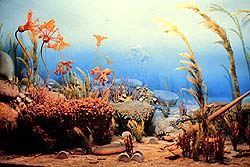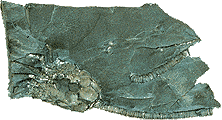| Interpreting Arisaig's Fossils  Many of the animals at Arisaig either lived anchored to the sea floor or
buried in the mud and silt below. Some, such as trilobites and snails, crawled on the sea
floor to scavenge food, while others (nautiloids) swam as predators. Most of the animals
that lived on or in the sea floor filtered the water to feed on microscopic plants and
animals. Many of the animals at Arisaig either lived anchored to the sea floor or
buried in the mud and silt below. Some, such as trilobites and snails, crawled on the sea
floor to scavenge food, while others (nautiloids) swam as predators. Most of the animals
that lived on or in the sea floor filtered the water to feed on microscopic plants and
animals.
Currents, tides and storms were needed to move the food to animals such as brachiopods,
corals, bryozoans and bivalves. By burrowing into the sea floor, bivalves and worms
greatly disturbed the thin, straight layers of mud and silt. This process is called
bioturbation.
Most of the rocks at Arisaig are rich in fossils, indicating an abundance of food,
oxygen and sunlight.
 Fossils Fossils
Silurian sea creatures were mostly invertebrates (animals without backbones). Layers of
broken shells, called coquina, are strong evidence of a climate dominated by storms.
Arisaig rocks and fossils were deposited in a warm, shallow sea more than 200 million
years before the dinosaurs evolved. There was not much life on land at that time, not even
plants, but the seas were alive with both strange and familiar creatures.
Some fossils are immediately visible in the rock while others can only be found after a
careful search. The drawings on the next pages will help you identify the many different
types of fossil animals that once lived at Arisaig.
 |
 |
 |
| Arisaig Sea Cliffs |
Important Sites Home |
Fossils of Arisaig |
|
![]()